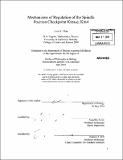| dc.contributor.advisor | Angelika Amon. | en_US |
| dc.contributor.author | Chan, Leon Y. (Leon Yen-Lee) | en_US |
| dc.contributor.other | Massachusetts Institute of Technology. Dept. of Biology. | en_US |
| dc.date.accessioned | 2010-09-02T15:00:36Z | |
| dc.date.available | 2010-09-02T15:00:36Z | |
| dc.date.copyright | 2010 | en_US |
| dc.date.issued | 2010 | en_US |
| dc.identifier.uri | http://hdl.handle.net/1721.1/58197 | |
| dc.description | Thesis (Ph. D.)--Massachusetts Institute of Technology, Dept. of Biology, 2010. | en_US |
| dc.description | Cataloged from PDF version of thesis. | en_US |
| dc.description | Includes bibliographical references. | en_US |
| dc.description.abstract | Most cells are polarized in that they are aware of spatial cues and can respond to these cues accordingly. One major aspect of cell function that is often responsive to these polarization cues is cell division. Cell division, the process of making two cells from one progenitor, requires equal distribution of the genetic material to the two progeny cells. When polarized cells divide, an additional constraint on the segregation of the genetic material is imposed, namely, cells must divide the genetic material along axes defined by polarization cues. In eukaryotes, this problem is generally solved by the positioning of the mitotic spindle according to these spatial cues. Defects in spindle positioning can lead to the generation of cells with incorrect organelle, genetic and molecular contents, fate and/or, spatial orientation. Cells have evolved feedback mechanisms that monitor defects in spindle positioning and delay the cell cycle in response to such defects. These mechanisms are best elucidated in the budding yeast, Saccharomyces cerevisiae. The protein kinase Kin4 inhibits the Mitotic Exit Network when the spindle is mis-positioned. How Kin4 is itself regulated and whether or how Kin4 responds to spindle mis-position is not known. The work presented in this thesis elucidates the regulation of Kin4. We identify a novel spindle position checkpoint component, PP2A-Rts 1, and show that it promotes checkpoint function by enabling proper Kin4 localization. We also identify domains and sequence determinants within Kin4 that control localization and function. We present a model of how the spindle position checkpoint senses spindle position and test this model for Kin4 function. We find that the generation of positive and negative mitotic exit regulatory zones allows the cell to sense and translate the spatial information of spindle position into a chemical cell cycle signal. | en_US |
| dc.description.statementofresponsibility | by Leon Y. Chan. | en_US |
| dc.format.extent | 168 p. | en_US |
| dc.language.iso | eng | en_US |
| dc.publisher | Massachusetts Institute of Technology | en_US |
| dc.rights | M.I.T. theses are protected by
copyright. They may be viewed from this source for any purpose, but
reproduction or distribution in any format is prohibited without written
permission. See provided URL for inquiries about permission. | en_US |
| dc.rights.uri | http://dspace.mit.edu/handle/1721.1/7582 | en_US |
| dc.subject | Biology. | en_US |
| dc.title | Mechanisms of regulation of the spindle position checkpoint kinase, Kin4 | en_US |
| dc.type | Thesis | en_US |
| dc.description.degree | Ph.D. | en_US |
| dc.contributor.department | Massachusetts Institute of Technology. Department of Biology | |
| dc.identifier.oclc | 654107446 | en_US |
